If you go to Pamplona, Spain, during the Festival of San Fermín, be sure to wear all white and tie a red handkerchief about your neck. Get dressed, look at yourself in the mirror and laugh if you must. But if you don’t dress 1)appropriately, you will most likely feel as 2)self-conscious as a 12-year-old child on his first day in a new school.
The Festival of San Fermín, first made famous outside of Spain by Ernest Hemingway in his novel The Sun Also Rises (1926), takes place each year from July 6th to July 14th. No 3)adjustment is made for the day of the week on which the dates fall. Therefore, if July 6th is a Tuesday, the festival starts on a Tuesday. Regardless of the day, the town 4)literally celebrates non-stop for the entire duration of the festival. The only 5)discernable break between one day and the next is the running of the bulls (“el encierro” in Spanish), which takes place each morning at 8 am.
Every kind of person can be found at the festival, but there are two major types of San Fermín 6)revelers. The most common is the one who parties all night and finishes the day by queuing up at 6 am to get a good view of the running of the bulls. Many of these partiers are encouraged – both by the festive spirit and the alcohol – to complete their day by joining the run.
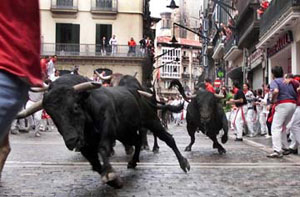 如果你在圣·费尔明节期间来到西班牙的潘普洛纳,记得要身着纯白衣裤,并在脖子上系一方红手帕。穿好衣服,照照镜子,如果实在忍不住的话,尽管大笑一番。不过如果你穿戴不合宜,就很有可能像一个第一天走进新学校的12岁孩子那样浑身不自在。
如果你在圣·费尔明节期间来到西班牙的潘普洛纳,记得要身着纯白衣裤,并在脖子上系一方红手帕。穿好衣服,照照镜子,如果实在忍不住的话,尽管大笑一番。不过如果你穿戴不合宜,就很有可能像一个第一天走进新学校的12岁孩子那样浑身不自在。
圣·费尔明节最早是因为欧内斯特·海明威的小说《太阳照常升起》(1926年)而走出西班牙国门并声名远播的,在每年的7月6日开始,7月14日结束。无论开始的那天是星期几,日期从不作调整。所以,如果7月6日是星期二,那么节日就从星期二开始。不论是白天还是黑夜,这座小城在节日期间都会毫不停歇地庆祝狂欢。唯一能够明显将一天和下一天区分开来的,就是每天早上8点开始的奔牛环节了(西班牙语为“el encierro”)。
你会发现在节庆上各色人等皆有,但是在圣·费尔明节上狂欢作乐的人主要有两种:最常见的是那些整晚宴饮作乐,第二天一早6点就开始排队,等着找个好位置欣赏奔牛的人。大多数宴饮者都会受到鼓动——不仅是节日的气氛,还有酒精的作用——去亲身参加奔牛来结束这一天。
Immediately after the running of the bulls has finished and the bulls have entered the 7)bullring (“Plaza del Toros” in Spanish), this group collects their sleeping bags from the bus station and wanders off to any piece of available green grass to have a sleep.
The other type of San Fermín reveler is the one who has spent the night in a car, a campground or a nearby town (hotel rooms in Pamplona are usually booked out one year 8)in advance of the festival), and who join the 9)previous night’s partiers in the “encierro” viewing queue at 6 am. They then begin to party just after the last bull has passed through the narrow streets and entered the 10)arena. The bars in Pamplona, during the festival, are as 11)hopping at 9 am as are most bars in Spain at 2 am on a Saturday – and that is no small 12)feat.
One should not think that San Fermín is 13)reserved only for those intent on damaging their livers with 14)excessive drinking. San Fermín is also a family festival with various areas set aside for children’s entertainment. There is at least one square that allows children the opportunity to be chased by a pretend bull. There is also a 15)carnival and traditional Basque Country注 sports such as stone lifting and tug-of-war.
For those who decide to run with the bulls, a 16)command of the Spanish language will most likely not be needed to make friends with the other runners. The majority of people running are foreign tourists.
One should also be aware that 17)valor is taken seriously during the running of the bulls. Therefore, any attempt by a 18)participant to jump out of the fenced-off 19)corridor before being in serious danger from a bull is likely to get that person pushed right back. Those choosing the safe route, and running well ahead of the bulls from the start, can expect to be 20)booed upon entering the Plaza del Toros. A list of injuries, along with the runner’s nationality, can be found in the local newspaper each day.
Bullfights, with the bulls who participated in the running of the bulls that morning, take place daily at 6:30 pm. Tickets can be purchased for the following days’ bullfights beginning at 8:00 each morning. If you are unable to purchase a ticket, they can be had from 21)scalpers outside of the arena during the fight. These tickets can be expensive.
After the festival has concluded, the locals put away their white shirts, white pants and red handkerchiefs until next year. While doing so, a smile may 22)curl on their faces as they remember the 23)novices who arrived so inappropriately dressed.
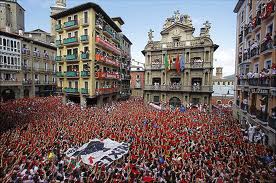 奔牛结束、牛群进入斗牛场(西班牙语为“Plaza del Toros”)之后,这群人会立刻从车站领回自己的睡袋,溜达去任何一块可以容身的绿草地睡上一觉。
奔牛结束、牛群进入斗牛场(西班牙语为“Plaza del Toros”)之后,这群人会立刻从车站领回自己的睡袋,溜达去任何一块可以容身的绿草地睡上一觉。
而另一种在圣·费尔明节上狂欢作乐的则是那些在车上、露营地或附近城镇度过了一夜的人(潘普洛纳的酒店房间通常在节庆的前一年就被提前预订完),他们会加入到前一晚的宴饮者队伍当中,从6点开始排队等着看奔牛。接着,当最后一头牛奔过狭窄的街道进入斗牛场之后,他们开始加入到派对当中。节庆期间,
潘普洛纳的大小酒吧在上午9点时的忙碌状况就如同西班牙大多数酒吧在周六凌晨两点时一样——这可不是一件小事。
你可不要把圣·费尔明节看成是只为那些豪饮伤肝的人而设的。
圣·费尔明节也是一个合家欢庆的节日,它也为孩子们的游乐预留了各种场地。至少有一个广场让孩子们有机会被一只假牛追赶。同时还会有嘉年华会和传统的巴斯克地区运动,如举石头和拔河。
对于那些决心要与牛同奔的人来说,想和其他奔牛者结交朋友不一定要掌握西班牙语,因为大多数奔跑者都是外国游客。
还需注意的是,在与牛同奔的时候,英勇无畏是必不可少的。因此,如果一个参与者在被公牛撞成重伤之前试图跳出由栅栏隔出的通道,他很可能会被人们推回去。而那些选择安全路线,自始至终都轻松跑在公牛前面的人,进入斗牛场时可能会遭到嘘声一片。每天早上,在当地报纸上都能找到伤者的名单及其国籍。
斗牛于每天下午六点半开始,牛则是当天早上进行过奔牛的公牛。每天早上8点钟可以购买后几天斗牛节目的门票。如果买不到门票,你也可以在斗牛进行期间从场外的黄牛党那里购买。这些票可能相当贵。
节庆结束后,当地人会收起他们的白衬衣、白裤子和红手帕,留待来年再用。收拾衣物时,他们想起那些初到此地、衣着不合宜的新手们,脸上也许会漾起一丝微笑。
What happens during the festival? 节庆期间有什么节目?
Nothing can prepare you for your first Pamplona experience. The Spanish sure know how to party and the famous Festival San Fermín is no exception. Truly something that must be experienced first hand – there is a whole lot more to this festival than running with the bulls!
Opening 24)Ceremony – the “25)Fiesta San Fermín” is officially opened at midday.
Traditional dress for the Festival consists of a white shirt and trousers with a red waistband and neckerchief.
During the day you can expect 26)atmospheric singing, dancing, 27)copious amounts of 28)sangria and non-stop partying in the streets.
The Bull Runs – the best-known event of the festival is the “encierro.” This event is held each morning at 8 am from July 7th to 14th.
Runners do not need to enter, simply turn up before 8 am in preparation for the run, which is 29)approximately 830 metres long.
The runners begin and are followed by six Spanish Fighting Bulls, which are 30)herded by six 31)steers.
The bulls run through the streets and on into the arena.
32)Parade of the Giants – held each morning with giant-sized figures dancing and 33)swirling in the streets.
Bullfights are held each evening from 6:30 pm in the arena when three 34)matadors fight two bulls each.
At 11 pm each evening, fire bull is let loose for the children to play with. (Firecrackers are placed on the horns of a bull. Nowadays, the bull is often replaced by a runner carrying a frame on which fireworks are placed.)
A firework display is put on each evening near the old 35)Citadel at 11 pm.
Closing Ceremony – the locals gather in the main square, the Plaza de Castillo, to form a candle light 36)procession to the old church to bid farewell to the festivities for another year.
你根本无法想象你的首次潘普洛纳之旅。西班牙人对聚会玩乐果然很在行,著名的圣·费尔明节当然也不例外。这确实是必须亲身经历的事情——除了奔牛,这场节庆还有更多节目值得你去体验哦!
开幕式——“圣·费尔明狂欢节”于正午时分正式开始。
传统的节日服装包括一件白衬衫和一条白裤子,以及一条红腰带和一块红颈巾。
在白天,你能欣赏到激动人心的歌曲和舞蹈,品尝到大量的桑格利亚汽酒,参加街上永不停顿的派对。
奔牛——节庆中最有名的节目就是“奔牛”。该节目在7月7日至14日的每天早上8点开始。
奔牛者无需入场,只要在8点前到场为奔牛做好准备,所跑距离约为830米。
奔牛者开跑,后面跟着6头西班牙斗牛,由6头阉牛带领向前冲。
公牛沿着街道狂奔,一直冲进斗牛场。
巨人游行——每天早上举行,有巨大的人像在街道中起舞旋转。
斗牛于每天傍晚六点半在斗牛场举行。有3名斗牛士参加,每人斗两头公牛。
每天晚上11点,放出火牛给小朋友玩耍。(人们在一头公牛的角上绑上烟花。如今,公牛通常由一位奔牛者举着绑着烟花的模型代替。)
烟花表演于每天晚上11点在旧城堡举行。
闭幕式——当地人聚集在主广场——卡斯蒂罗广场上,组成一支烛光游行队伍一直走到老教堂,向庆典告别,期待来年节庆的到来。


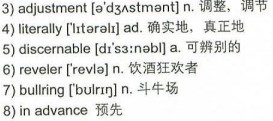
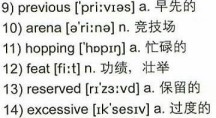
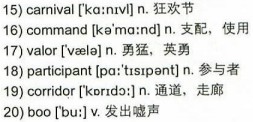
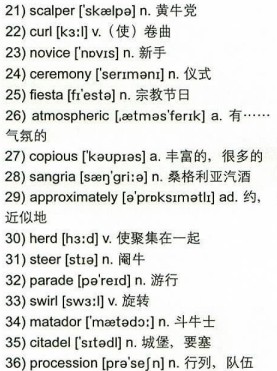
奔牛节的来历
西班牙一年一度的奔牛节的正式名称叫“圣·费尔明节”,圣·费尔明是西班牙东北部富裕的纳瓦拉省省会潘普洛纳市的保护神。奔牛节的起源与西班牙斗牛传统有直接关联。据说当初对潘普洛纳人来说,要将6头高大的公牛从城郊的牛棚赶进城里的斗牛场是件非常困难的事情。17世纪时,某些旁观者突发奇想,斗胆跑到公牛前,将牛激怒,诱使其冲入斗牛场。后来,这种习俗就演变成了奔牛节。1923年,美国著名作家海明威首次来到潘普洛纳观看奔牛并写成了著名小说《太阳照样升起》,他在作品中详细描述了奔牛节,奔牛节因而声名远播。1954年海明威获得诺贝尔文学奖后,西班牙奔牛节更是名声大噪。当地居民为了感谢海明威为奔牛节做出的贡献,特地在斗牛场的大门口,为他竖起了一座雕像。
